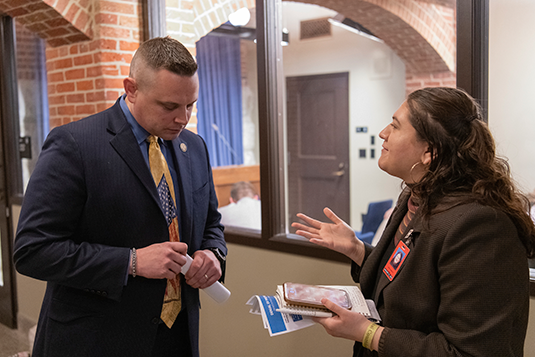By Emily Sheftman
In the 1970s newspaper publisher Paul Simon decided Illinois needed better trained public policy reporters. Simon, then the state’s lieutenant governor, had some time on his hands after losing the March 1972 race for the Democratic nomination for governor. So, as a faculty member at Sangamon State University in Illinois’ capital city of Springfield, he started the Public Affairs Reporting program in the fall of 1972.
The bow-tied publisher led PAR for two years before being elected to Congress, including two terms in the U.S. Senate. Now 50 years later, the program he started continues to thrive – as part of the University of Illinois Springfield, which took over Sangamon State in 1995 – providing an affordable, hands-on learning experience and producing a new class of political reporters every year.
The 10-month program costs Illinois residents about $6,000 after factoring in tuition waivers, scholarships and stipends, current director and former journalist Jason Piscia said. The intensive experience starts with a crash course in all things legislative and ends with six months of direct in-the-Statehouse reporting, Piscia said.
Because the program offers an exceptionally low-cost model for a graduate degree it also brings new people into the field, Piscia said.
“We're trying to bridge that gap and attract some people into graduate school that might have never considered that graduate school was an option for them,” Piscia said. “That diversifies the people we attract into journalism and that are practicing reporters. And that just helps how we cover things and the points of view of our staff members and brings a whole array of backgrounds into the fold. And that makes journalism better.”
The program starts in August with a series of core courses in legislative policy making and advanced reporting and a series of simulations to get students ready for the start of the legislative session, Piscia said. In January, students are placed with news organizations with bureaus in the state’s Capitol, working full time as political reporters, side by side with professional journalists, covering the Statehouse and the governor. Piscia works with students individually as needed, providing editing and writing support.
The program has the added benefit of addressing declines in Statehouse news coverage, Piscia said.
“We've all seen the reports from Pew and others about the declining number of full-time journalists covering statehouses across America. And Springfield's been no exception to that,” Piscia said. “There are currently less than a dozen full time statehouse news correspondents. With nine to 10 students per semester, I can almost double the population of the Statehouse press room. This means we can cover more committees, more news conferences, do more in-depth things, just cover a lot more ground than what the press corps can do at any other time of the year,” Piscia said.
And covering statehouses has never been so important, Piscia said.
“I think it's probably the most important level of government since it has the ability to touch so many people on a very significant basis, even more than the federal government and even more than local government. So it's important that we're watching what all these people are doing,” Piscia said.
And Piscia knows what he is talking about. He graduated from the program in 1998 and stepped into a job as a reporter at the daily paper in the capital city, The State Journal-Register, where he worked for 21 years before returning to the university.
Currently, the program has nearly 100 percent employment for students after graduation. Piscia believes this to be the result of the program being “well known for producing graduates that are ready to hit the ground running on day one. So those resumes always tend to float to the top of the pile. And that's mainly because of the reputations of the graduates we produce.”
Moving forward, Piscia hopes to make the program even more accessible to students from diverse backgrounds by offering more remote options for the fall courses and establishing internships that allow students to cover state government from other regions of Illinois.
For more information:
facebook.com/UISpringfield.PAR
Jason Piscia jason.piscia@uis.edu


